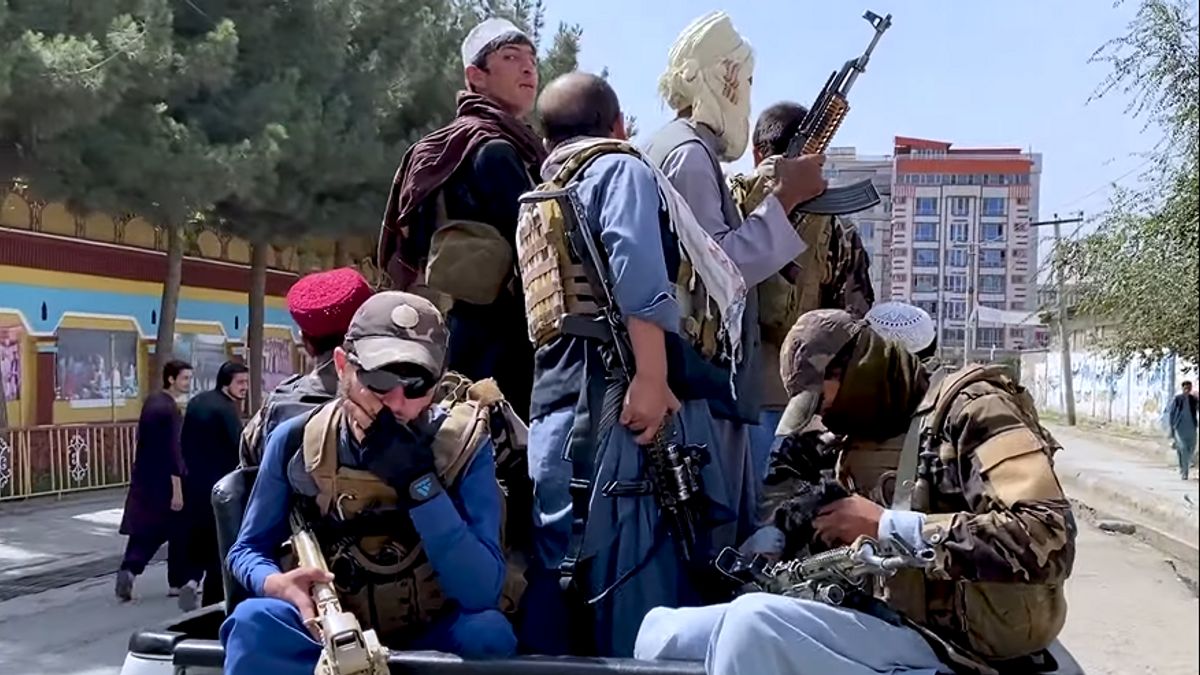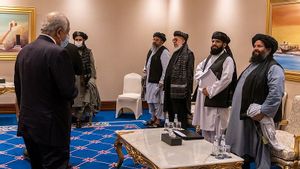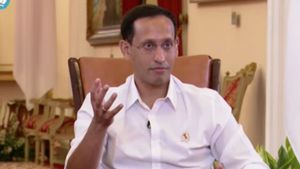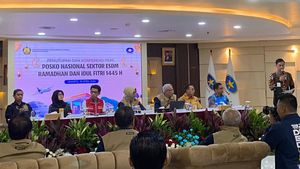
JAKARTA - The bombing at Kabul Airport, Afghanistan which was claimed to be the work of ISIS Khorasan (ISIS K) became a sign of the rivalry between the Taliban and ISIS. The two organizations have the same direction, namely the ultra-conservative. But the question is why do they often fight each other?
The Islamic State group K claimed responsibility for a suicide bombing outside Kabul Airport that killed at least 60 people including a dozen US troops on Thursday, August 26. The attack is believed to be the deadliest event for US troops in Afghanistan in a single incident since 30 US personnel were killed in a helicopter when it was shot down in August 2011.
The Taliban immediately condemned this incident. "The Islamic Emirate strongly condemns the bombing of civilians at Kabul airport, which took place in an area where security is in the hands of US forces," Taliban spokesman Suhail Shaheen wrote on his Twitter account as quoted on Friday, August 27.
As is well known, ISIS K, or the Islamic State of Khorasan Province is a group affiliated with ISIS in Afghanistan and Pakistan. The group was founded in 2015, the peak of ISIS' power in Iraq and Syria. Meanwhile, the relationship between ISIS and the Taliban in Afghanistan is full of dynamics. Even though they share the same ideology, their style of movement and goals are different. No doubt, these two ultra-conservative organizations often clash.
At the end of 2017, for example, they also often clashed. As quoted by VOA, at that time there were more than 200 families leaving their homes in Khogyani district, eastern Nangarhar, when the two sides fought each other.
Ahmad Ali Hazrat, chairman of the Nangarhar provincial council at the time, explained that the clashes took place in areas under the influence of the Taliban. Some villagers, who see ISIS as an outside power, support the Taliban insurgents fighting.
This is not the first time Afghans have been displaced by clashes between the two groups. According to the Nangarhar provincial government, more than 2,000 families were displaced and at least eight civilians were killed in October 2017 when ISIS and the Taliban clashed for several days in the Waziro Tangi region.
The Islamic State militant group has also claimed responsibility for a number of deadly attacks on major Afghan cities. According to General John Nicholson, commander of US and NATO forces in Afghanistan, the ISIS group is reportedly planning to establish a "caliphate" in Afghanistan.

Taliban-ISIS
According to Aly Ashghor in his journal entitled "Taliban in Afghanistan: An Overview of Ideology, Movement and Its Alliance with ISIS" explains, the Taliban and ISIS do have the same ideological view, so ISIS is trying to build a new territory in Afghanistan as a power base after the destruction of ISIS in Syria. . While in Afghanistan itself, the globalization of the doctrine of jihad based on violence and terror in the late 20th century grew and developed under the protection of the Taliban.
One of the important factors for the process of accelerating the political consolidation of the Taliban movement in Afghanistan is the existence of disputes between mujahideen factions after the withdrawal of the Soviet Union so that the transition from the communist regime to the mujahideen regime did not go smoothly. The reason is that several factions of the Afghan mujahideen failed to find common ground in formulating a common platform to build Afghanistan after the Soviet withdrawal.
As a result, since 1988 post-Geneva Agreement which ended the war between the Afghan and Soviet mujahideen, Mohammad Najibullah, the leader of the mujahideen regime has still served as President with little Soviet assistance. In the period of transition of power after the withdrawal of the Soviet Union from Afghanistan which gave birth to uncertainty about the future of Afghanistan's development, a new force based in Kandahar Province, known as the Taliban, was led by Mullah Umar.
Since Afghanistan came under the control of the Taliban regime in 1996, Mullah Umar as the leader of the Taliban promised Islamic doctrine in the midst of a more strict and puritanical society. In the midst of the uncertainty of Afghanistan's future in the bloody transitional period of government after the end of the Soviet war, the Taliban regime built a traditional Islam-based and puritanical system of government based on Sunni Deobandi, which has a Wahhabi sect genealogy.
Since then, the Taliban has promoted an agenda of strict application of Islamic law that does not compromise with the changing times. On that basis, the Taliban movement formed the identity of the Afghan nation through a political, social, and cultural revolution based on conservative Islam.
This revolution cannot be separated from the role of youth or Madrasa students in the Afghanistan-Pakistan border region who have inherited the tradition of Wahhabi ideological thought through the Deobandi Sunni sect. Therefore, it is not surprising that Afghanistan became the earth where the mujahideen took refuge from various countries
In fact, on the basis of ideological similarities and religious thought, the Taliban became a protector for Osama bin Laden. Including the declaration and planning of al-Qaeda terror acts organized and planned in Afghanistan. The close relationship between the Taliban and al-Qaeda lasted from 1998 to 2001.
Take advantage of the situation
In 2019, ISIS lost nearly 99 percent of its territory in Syria-Iraq to US-led coalition strikes. However, losing territorial control over many areas in Syria and Iraq did not end the ISIS struggle. ISIS sympathizers and supporters are still trying to fight for and defend the Islamic Caliphate or Islamic State by building new territories outside Iraq-Syria.
One area that is currently a new territorial arena of struggle for supporters and sympathizers of ISIS ideology is the ISIS branch of Khurasan, Afghanistan, which has existed since 2015. The ISIS group in Khurasan, Afghanistan, since 2019 has begun to build a new alliance with the Taliban with the aim of making Afghanistan the main axis of ISIS territory and strength.

This effort found its momentum when the North Atlantic Treaty Organization (NATO) coalition forces and the United States gradually began to withdraw from Afghanistan under US President Joe Biden. This troop withdrawal is a follow-up to the peace agreement between the Taliban and the US signed in Qatar on February 29, 2020.
However, in development, not all elite figures in the Taliban circle agreed to the US-Taliban peace agreement agreed in Qatar. The situation of divided members of the Taliban in responding to the peace agreement was used by ISIS to recruit members of the Taliban who were not satisfied with the peace agreement with the United States.
This is confirmed by research conducted by the Center for Strategic Studies of Afghanistan, which says that five out of 20 percent of Taliban fighters are likely to join ISIS. In fact, US officials and military experts estimate there are an estimated 2,500 ISIS members in Afghanistan, but that number could rise if Pakistani militias join them.
Rivalry
Apart from the existing disputes within the Taliban, what needs to be known is that this organization, as the University of Indonesia International Relations Lecturer Ali Wibisono, is called, is a political entity. So even if the Taliban today fight ISIS, it is not impossible that someday they can make peace.
"The Taliban is a political entity. This means that they are scheming every time, when it's time for war, when it's time to retreat and hide. They are really good at it," Ali told VOI.
So, for example, in 2014 the Taliban had declared an end to the war with ISIS, it was simply because there was still US power. "Because both of them are fighting the US. "The enemy of my enemy is a friend."
That means when ISIS fights the US, the Taliban will not fight them. Unlike now when the US has left Afghanistan. "Now that the US has left, they are at war."
Ali explained that although they both wanted to enforce Islamic law, the features and goals between the Taliban and ISIS-K were different. The Taliban is an ethnic group based on the Pashtun ethnic group. While ISIS-K is an extremist Sunni group whose goal is to establish a caliphate between countries.
"They (Taliban) do not consider themselves to be part of a global caliphate. If the caliphate crosses national borders, it knows no national borders. The Taliban only wants to have Afghanistan coverage," Ali explained.
In line with Ali, Terrorism Observer Harits Abu Ulya also told VOI that the goals of the Taliban and ISIS-K are indeed opposite. ISIS-K doesn't even acknowledge the current success of the Taliban.
In the current unstable situation in Afghanistan, Harits said, this has become a weakness that the ISIS-Khurosan group has exploited to carry out demonstrations. For this reason, the Taliban has a big task to bring Afghanistan, especially the security and peace aspects, to a conducive condition.
"This is a weakness used by the ISIS-Khurosan group to take action as a signal of their existence to be taken into account. Naturally, the condition of the state or government in the transition and consolidation phase, for the Taliban it is a big task to immediately bring Afghanistan's conditions, especially aspects of security and peace into stable and conducive conditions," said Harits.
*Read other information about TALIBAN or other interesting articles from Ramdan Febrian Arifin.
Other NEWS
また読む:
The English, Chinese, Japanese, Arabic, and French versions are automatically generated by the AI. So there may still be inaccuracies in translating, please always see Indonesian as our main language. (system supported by DigitalSiber.id)

















